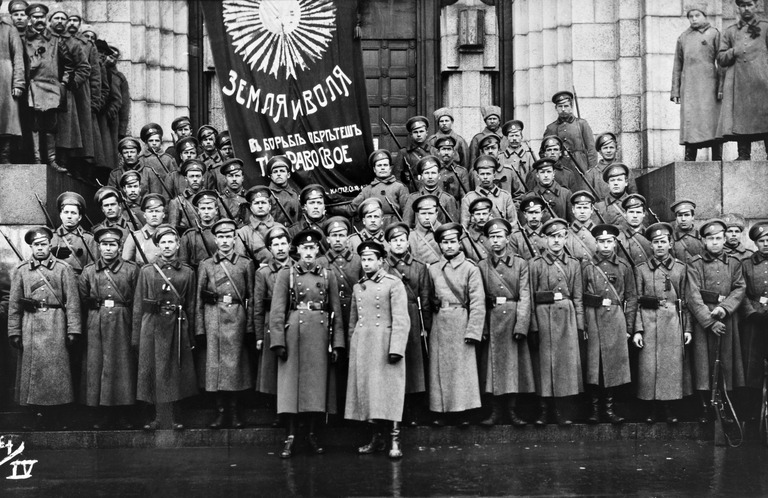The Russian Emperor and Grand Duke of Finland Nicholas II abdicated on 15 March 1917. His brother Grand Duke Mikhail refused to accept the crown. A committee set up by the Duma started to govern Russia. People began calling the committee the provisional government.
The new government was chaired by Prince Georgy Lvov. The change of power also liberated the political life of Finland, as the March Manifesto issued by the Lvov government repealed regulations restricting Finland’s autonomy. Oskari Tokoi, a Social Democrat, formed a multi-party government and parliamentary work started.
Major losses suffered by Russia in the Great War and the food shortage led to the March Revolution. By March 1917 Russia had lost nearly one million men in the war. In addition, more than two million had been wounded and nearly three million were missing. The army’s support for the Emperor began to falter. More and more people at the Imperial court, in the Duma and in the General Staff voiced their views that reform was needed. The shortages of food and consumer goods led to discontent among citizens, which, in turn, resulted in strikes and demonstrations.
The Emperor became citizen Romanov
The Emperor was overthrown as a result of an uprising which broke out a week before Nicholas II’s abdication. The Emperor tried to use the army to suppress the demonstrations, but one after the other the battalions switched over to the revolutionaries’ side. Nicholas II also ordered the Duma sessions to be suspended. However, most of the Duma members began resisting and started to lead the revolution. In St. Petersburg, people set up workers’ and military councils, which constituted the more radical wing of the revolution.
A. I. Guchkov and V. V. Shulgin, representatives of the Russian parliament, or the Duma, and Grand Duke Nicholas Nikolaevich, as well as commanders of the Russian army, which had suffered heavy losses, persuaded Nicholas II to abdicate on 15 March.
Nicholas II transferred the crown to his brother, Grand Duke Mikhail Alexandrovich, who, however, refused to accept the crown. The Romanov era in Russia ended. The Emperor became an ordinary citizen.
A temporary committee set up by the fourth Duma of the Russian Empire, dissolved on 10 March by the ruler Nicholas II, assumed the powers of the Tsar. A provisional government started to rule Russia. Its constitutional legitimacy was questionable, but foreign powers soon recognised it as Russia’s legitimate government. The prime minister was also the head of state. Russia became a parliamentary country, although formally it was a monarchy in which the power of the Tsar was wielded by the prime minister. Russia’s form of government and state structure were to be decided by the Russian Constituent Assembly, which was to be elected later.
In Finland, the change of power occurred on 16 March
On the day following the Emperor’s abdication, 16 March 1917, Russia’s Baltic Fleet Commander Adrian Nepenin gave orders for the capture of the Governor-General of Finland, F. A. Seyn, and Vice Chairman of the Senate Finance Department (Prime Minister), Mikhail Borovitinov. They were detained and transported to St. Petersburg by train.
The change of power in Russia caused unrest in various parts of the country. The provisional government appealed to the leaders of the Finnish parties to maintain order. By political concessions it sought to secure the good relations resulting from the revolution as the war against Germany continued.
At the request of the provisional government, Admiral A. I. Nepenin, commander of the Baltic fleet, also appealed to the Finnish party leaders to maintain order. His appeal was published in several Finnish newspapers, including Uusi Suometar on 16 March, and Työmies on 18 March. Labour organisations reacted quickly to Nepenin’s appeal. Their statements calling for the preservation of order spread to large audiences, especially through Työmies.
The March Manifesto restored autonomy
From the Finnish standpoint, the first important decision of the provisional government was its declaration on 20 March 1917, called the March Manifesto. The Manifesto repealed most of the regulations restricting the Finnish autonomy, ending the second Russification period.
The declaration was preceded by several rounds of talks. On 18 March, a delegation representing all Finnish parliamentary groups left for St. Petersburg. The draft of the Manifesto was based on the non-socialist parties’ views based on cancelling the Russification measures. At this point, the Social Democrats were more willing than the non-socialists to acknowledge the provisional government’s control over matters concerning Finland. The socialists hoped for social reforms in return. At this stage, the Finns recognised the provisional government as “the holder of full state powers”.
The new Governor-General understood Finland’s position
On 19 March, the Russian provisional government appointed Mikhail Stakhovich, a member of the upper house of the Duma, as the new Governor-General of Finland. He belonged to a moderate right-wing party called the October Union. In the Duma, Stakhovich had defended the rights of Finland. His assistant was Professor, Freiherr Sergei Korff, who had lived in Finland for a long time. On 26 March, the provisional government appointed the Senate of Finland, led by Oskari Tokoi.
By decision of the Senate, the unofficial red-and-yellow Finnish lion flag was hoisted on the flagpoles of the Government Palace and Helsinki City Hall on 21 March. At the same time, the Senate repealed the decree of 6 April 1914 on flying the flag and setting up festive lighting on imperial holidays. It also ruled that portraits of Nicholas II on walls of government agencies and schools should be taken down.
The March revolution also ended the postal and press censorship. Articles and pictures in newspapers were no longer accompanied by the letters S. H. (“censorship approved”).

